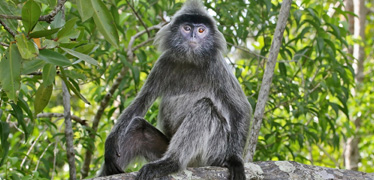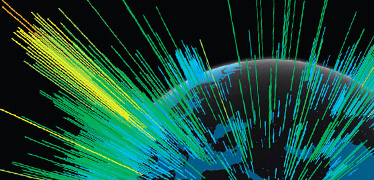Planktonic forminera

Scanning electron microscope (SEM) image showing a fossilised planktonic foraminifera, Globorotalia scitula.
Project summary
- Focus: Investigating marine microplankton evolution and the importance of adaptive zones in macroevolution
- Funding: NERC
- Start date: 2015
- End date: 2018
We are leading a growing programme of research on planktonic foraminifera, using their excellent fossil record to draw conclusions about evolutionary dynamics.
A clade of open-ocean protists, planktonic foraminifera have one of the best fossil records of any organism because of their large population sizes and wide distribution. We can access these fossils in cores sampled regularly by ocean drilling programmes.
Single-celled planktonic foraminifera and calcareous nannoplankton (coccolithophores) are two key and abundant components of the ocean’s microplankton community. Their fossil record provides an extraordinarily continuous and complete history of changes in the surface ocean ecosystem over millions of years.
Projects
Marine microplankton evolution in response to ancient global cooling
PhD student: Isabel Fenton
Investigating changes in the diversity of these microplankton through the Eocene and into the Oligocene, as Earth’s climate changed from greenhouse to icehouse conditions. This involves comparing the functional and ecological diversity of these microplankton with their taxonomic diversity, both spatially and temporally.
The project aims to discover how these different kinds of microplankton diversity affect ocean productivity (the level of carbon production in the ocean) – in particular, what circumstances lead to increased productivity.
Isabel is comparing the response of foraminifera and coccolithophores to stratification and ocean productivity.
This project is part of the Descent into the Icehouse consortium.

Globigerina (planktonic foraminifera) ab. 500 µm © Hannes Grobe. Creative Commons Attribution 3.0 Unported license.
Are adaptive zones important in macroevolution?
GG Simpson defined an adaptive zone as a set of niches, sufficiently alike that a species adapted to one will readily be able to adapt to them all. The concept has been central to ideas about adaptive radiations and red queen evolution.
Empirical evidence for the importance of adaptive zones in macroevolution is scarce, because few systems have a sufficiently detailed fossil record and because of the need to study stable environments.
What is the role of adaptive zones?
This project will test whether adaptive zones are important to the dynamics of communities, lineages and traits. We will use new data obtained from the clade with the best fossil record of all – planktonic foraminifera, from the world’s most stable ecosystems – subtropical gyres.
Museum staff
External collaborators
- Paul Pearson
University of Cardiff - Tom Ezard
University of Southampton - Tracy Aze
University of Leeds
Publications
Ezard T H G, Thomas G H & Purvis A (2013). Inclusion of a near-complete fossil record reveals speciation-related molecular evolution. Methods Ecol Evol, 4, 745-753.
Aze T, Ezard T H G, Purvis A, Coxall H K, Stewart D R M, Wade B S & Pearson P N (2013). Identifying anagenesis and cladogenesis in the fossil record. P Natl Acad Sci USA, 110, E2946-E2946.
Ezard T H G, Pearson P N, Aze T & Purvis A (2012). The meaning of birth and death (in macroevolutionary birth-death models). Biol Letters, 8, 139-142.
Ezard T H G, Aze T, Pearson P N & Purvis A (2011). Interplay between changing climate and species' ecology drives macroevolutionary dynamics. Science, 332, 349-351.
Aze T, Ezard T H G, Purvis A, Coxall H K, Stewart D R M, Wade B S & Pearson P N (2011). A phylogeny of Cenozoic macroperforate planktonic foraminifera from fossil data. Biol Rev, 86, 900-927.
Glossary
Red queen evolution
The theory that organisms must constantly adapt and evolve not only to gain a reproductive advantage, but also to survive in a changing environment alongside ever-evolving opposing organisms
Funded by


Biodiversity research
We are creating molecular and digital tools to explore undiscovered biodiversity

Biodiversity research
We are creating molecular and digital tools to explore undiscovered biodiversity

Collections
The Museum's 80 million specimens form the world’s most important natural history collection